“It is not the strongest of the species that survive, nor the most intelligent, but the one most responsive to change.“
C.Darwin

RESEARCH.//
Dragonflies are part of the first winged archaic insects family which has been on this planet even long before dinosaurs, dating back to the late Carboniferous period about 300 million years ago. They belong to the order Odonata, suborder Anisoptera – from Greek ἄνισος anisos “uneven” and πτερόν pteron, “wing“, because the hindwing is broader than the forewing. Although one of the oldest insects still around today they have not changed much from their ancestors. It is believed that by some scientists that high oxygen levels during the Paleozoic era allowed dragonflies to grow to monster size up to 75cm wing span, whereas now they can be found about 3-10cm.
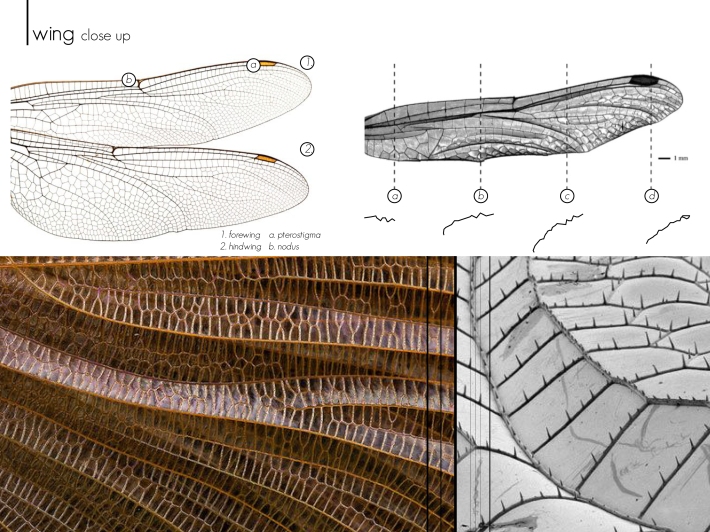
The wings are build up in this architectural structure made of veins starting from the root, where the blood flow keeps them moving and rigid, and a transparent membrane. All four wings are directly connected to the thorax of the dragonfly, the “mechanism” of this fine flyer. This is the mesosoma of the dragonfly and it bringing together all of its part: head, wings, legs and abdomen.
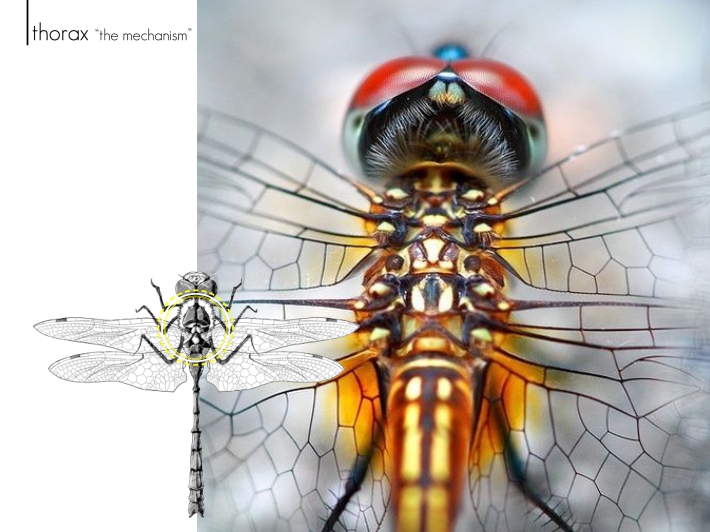
Unlike any other insects dragonflies fly in a direct flight: this means their wings are supported by four different and individual muscles. Each muscle can contract and relax whilst their body maintains its shape (see in comparison to indirect flight). The following illustrations show the structure of the muscles inside the thorax.
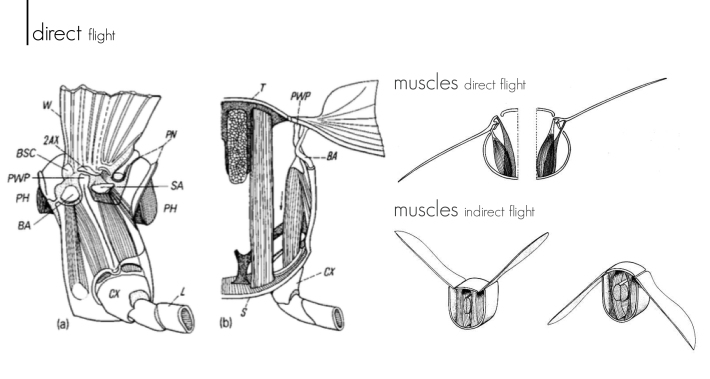
Besides being able to move all four wings independently, this almost flawless insect makes the best out of its structure by directing them in all three axis and combine flying directions: horizontal (flapping), vertical (lagging) and torsional (feathering). It basically creates an imaginary bending sphere around its body that can direct it anywhere very fast and steady assuring a meal for this air predator with a miss of only single digits percentage. This ability definitely creates a beautiful and graceful sequences of wing movement, but at the same time I believe it hides an even more intriguing pattern: the negative air flow around it.
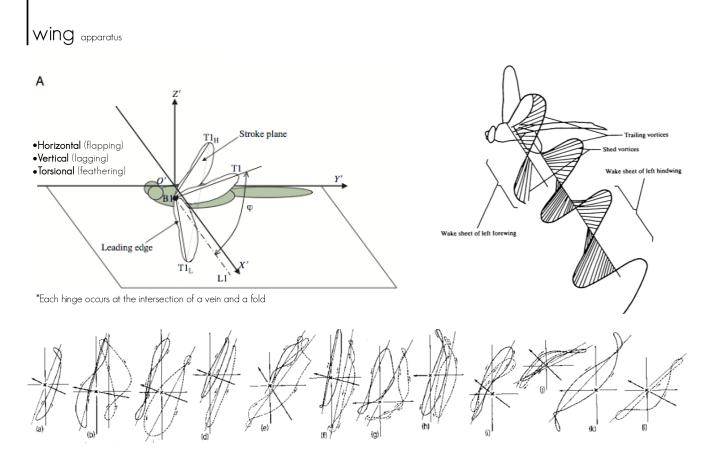
The air flow has been studied by having the dragonflies flying in the above mentioned modes in an environment filled with smoke in order to map down the circulation. Each flying direction, combination or even wing section creates a different air flow.
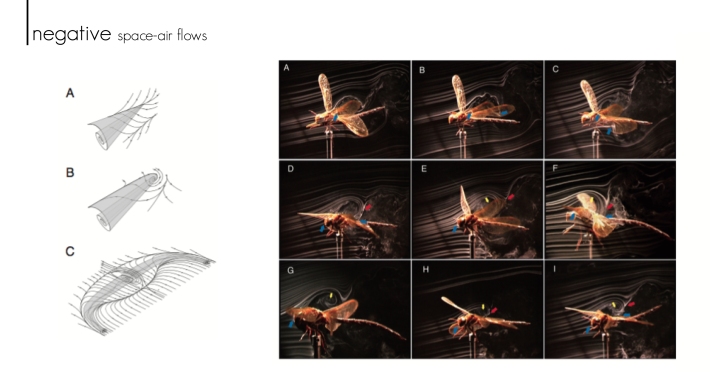
This precisely designed technology does not stop here since it has its own cooling system in order to have the thorax keep on going for all these complex flying. Just between the head and the rest of the thorax dragonflies have this small opening the dorsal trachea ,which allows air to go through where the wings are attached, making sure that the “mechanism” is at the right temperature at all times. In the following sequences of this slow motion wings video you may notice the opening expanding on the top of the thorax.(clip 0:46-1:14min)
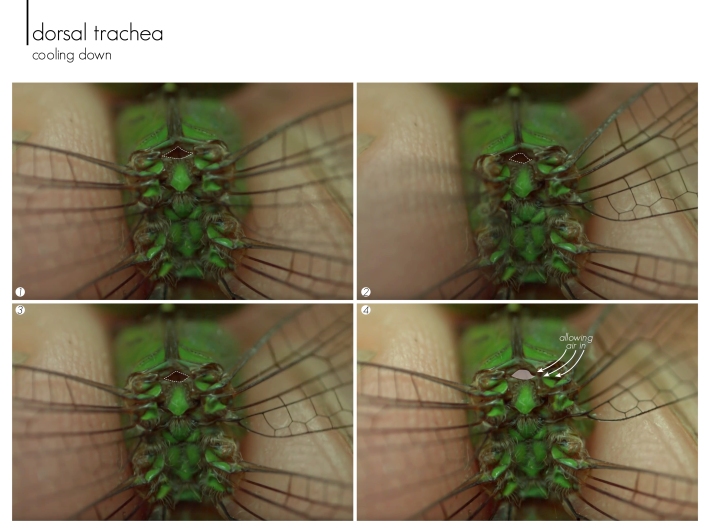
IDEA.//
After studying this series of flying and cooling principles of the dragonflies my main idea for the Moroccan desert has been developed versus kinetic architecture. An active kinetic facades which has the core abilities of a dragonfly wings three axis motion that could contribute to the building a thermal mass regulation by using the dorsal trachea cooling system at the thorax and derive aesthetically from the beautiful pattering of negative air flow space created by the wings membrane while flying.
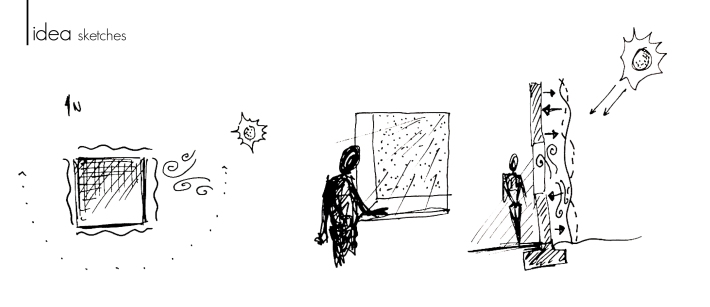
Since the local climate is very arid the motion of the facades membrane will aim to create an air flow, just like a draft. At the same time by warping itself around the building the facades can be part of the local culture and replace the light filtering mashrabiyas at the openings of the building.
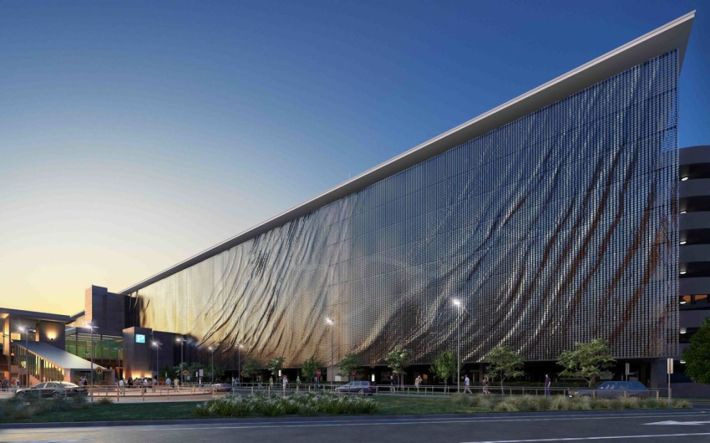
Ned Kahn: Wind Veil – North Carolina, 2000
The example above, an art installation by Ned Kahn in North Carolina, shows how the active flow of air can shape a facades. In this case the air flow creates a membrane in motion, rather than creating air flow by a moving membrane. Based on the negative space air flow that the wings of the dragonfly creates I would like to design a pattern of motion moved in the three axis, as shown below in sketch, that will be the active moving membrane for the building.
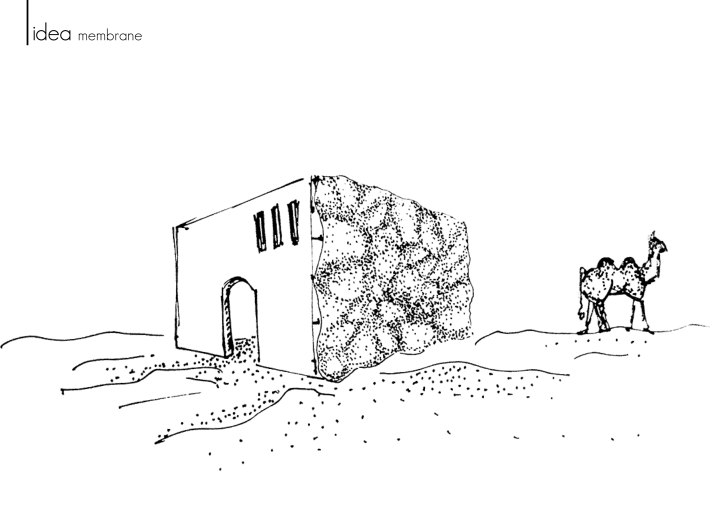
Nataly Timotheou.//
REFERENCES.//
Books:
1) Dragonflies, Miller, Peter Lament, Richmond Publ., cop. 1995
2) The Biology of Dragonflies (Odonata or Paraneuroptera), Arthur E.,Shipley, Sc.D., F.R.S., Master of Christ’s College, Cambridge, Cambridge Zoological Series
Articles:
3) Dragonfly flight: free-flight and tethered flow visualizations reveal a diverse array of unsteady lift-generating mechanisms, controlled primarily via angle of attack, Adrian L. R. Thomas*, Graham K. Taylor, Robert B. Srygley†, Robert L. Nudds‡ and Richard J. Bomphrey, Department of Zoology, Oxford University, South Parks Road, Oxford, OX1 3PS, UK
4) Flight Mechanics of a Dragonfly, by Akira Azuma, Soichi Azuma, Isao Watanabe Andtoyohiko Furuta, Institute of Interdisciplinary Research, Faculty of Engineering, The University of Tokyo, Tokyo, Japan, September 1984
5) Structural Analysis of a Dragonfly Wing, S.R. Jongerius & D. Lentink
6)Experimental investigations of the functional morphology of dragonfly wings, H. Rajabi† and A. Darvizeh
7)Insect Flight Mechanisms: Anatomy and Kinematics, Carl R. Knospe, Associate Professor Mechanical and Aerospace Engineering University of Virginia, Fall 1998
Online: